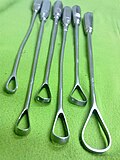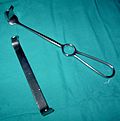There are many different surgical specialties, some of which require specific kinds of surgical instruments to perform.
General surgery is a specialty focused on the abdomen; the thyroid gland; diseases involving skin, breasts, and various soft tissues; trauma; peripheral vascular disease; hernias; and endoscopic procedures.
Instruments can be classified in many ways, but, broadly speaking, there are five kinds of instruments.
- Cutting and dissecting instruments
- Grasping or holding instruments
- Hemostatic instruments
- Retractors
- Tissue unifying instruments and materials
Instruments used in surgery are:
| This list is incomplete; you can help by adding missing items. (August 2008) |
| Instrument Name | Image | Brief description | Specific instruments |
|---|---|---|---|
| Electrical cautery | 
|
Electrical surgical cauterization utilizes electricity in either a monopolar or bipolar format to burn soft tissue and control bleeding |
|
| Curette | 
|
For scraping or debriding biological tissue or debris in a biopsy, excision, or cleaning procedure | |
| Dermatome | 
|
Removes epidermis to graft over another area | |
| Dissecting forceps | 
|
Grasping and holding; usually used in skin closures or small wounds | Adson |
| Tissue forceps | 
|
Grasping and holding tissue | Allis |
| Penetrating towel clamp | 
|
Used to secure towels or reduce bone fragments | Backhaus penetating towel clamp |
| Carmalt forceps | Hemostatic forceps | Kalabasa | |
| Cushing forceps | Grasping and holding | Non-toothed dissecting forceps | |
| Dandy forceps | Hemostatic forceps | ||
| DeBakey forceps | 
|
Grasping and holding | Non-toothed dissecting forceps designed for use on blood vessels, organs, or delicate tissue |
| Doyen intestinal clamp | Clamps and distractors | Non-crushing clamp designed for use on the intestines | |
| Kelly forceps | 
|
Hemostatic forceps | |
| Kocher forceps | 
|
Hemostatic forceps | |
| Mosquito forceps | 
|
Hemostatic forceps | |
| Hook | Retractor | ||
| Nerve hook | Retractor | ||
| Skin hook | Retractor | ||
| Lancet (scalpel) | 
|
Cutting | |
| Mammotome | 
|
||
| Needle holder | 
|
Grasping and holding |
|
| Retractor | 
|
Retractor | Handheld:
Self-retaining:
|
| Ultrasonic scalpel | Cutting | ||
| Laser scalpel | 
|
Cutting | |
| Scissors | 
|
Cutting and spreading | May be curved or straight |
| Speculum | 
|
Used to retract orifices |
|
| Suction tube and Yankeur suction tip | 
|
Accessories and implants | |
| Surgical elevator | 
|
||
| Surgical hook | 
|
Retractor | |
| Surgical blade #15 | 
|
Used to cut vessels or make small incisions | |
| Surgical mesh | 
|
Accessories and implants | |
| Surgical needle | 
|
Accessories and implants | |
| Surgical sponge | |||
| GIA stapler | 
|
Used to make a gastrointestinal anastamosis | Linear stapler |
| Surgical tray | |||
| Suture | 
|
||
| Tongue depressor | 
|
||
| Tonsillotome | |||
| Towel clamp | 
|
Clamp | |
| Towel forceps | Clamp | ||
| Backhaus towel forceps | 
|
||
| Lorna towel clamp | Non-penatrating towel clamp | ||
| Tracheotome | |||
| Tissue expander | Accessories and implant | ||
| Subcutaneous inflatable balloon expander | Accessories and implants | ||
| Trephine | 
|
Cutting instrument | |
| Trocar | 
|
Access instrument. Used to create an opening into a space without opening the abdominal cavity. A camera is inserted through one to view the interior while instruments are inserted through the others to manipulate the organs. | |
| Ultrasonic energy device | Surgical device typically used to dissect tissue, but also seals small vessels and tissue bundles |
References
- "ilizarov.com (English)". Archived from the original on 2013-01-26. Retrieved 2008-06-04.
- Children with Tracheostomies Resource Guide, by Marilyn K. Kertoy, p. 15 (Google book search)
- Rob Toreki (1 December 2004). "Cannulas". The Glassware Gallery. Interactive Learning ←Paradigms Incorporated.
- "Practical approach to nephrostomy". Archived from the original on 2005-11-03. Retrieved 2008-06-04.
- See Mr R McElroy for details of various operations and the unintended effects of chemical cauterization
- Ring, Malvin (July 2001). "How a Dentist's Name Became a Synonym for a Life-saving Device: The Story of Dr. Charles Stent". Journal of the History of Dentistry. 49 (2): 77–80. PMID 11484317. Archived from the original on 2005-04-28. Retrieved 2008-04-01.
- How do they get the hole through a hypodermic needle?
- Bonfils-Roberts, E (May 1972). "The Rib Spreader: A Chapter in the History of Thoracic Surgery" (PDF). Chest. 61 (5): 469–474. doi:10.1378/chest.61.5.469. ISSN 0012-3692. PMID 4558402. Archived from the original (PDF) on 2008-12-17. Retrieved 2008-04-22.
- "General Instrument Sourcebook - KMedic" (PDF). Archived from the original (PDF) on 2011-07-18. Retrieved 2011-02-10.
- Russell, R. C. G.; Bulstrode, C. J. K.; Williams, N. S. (25 April 2000). Bailey & Love's SHORT PRACTICE OF SURGERY (23rd ed.). Taylor & Francis. ISBN 0-340-75949-6.
- Gould, George M. (1934). Gould's Pocket Pronouncing Medical Dictionary (10th (rev) ed.). P. Blakiston's Son & Co., Inc.
- Cordero, Ismael (2015). "Electrosurgical units – how they work and how to use them safely". Community Eye Health. 28 (89): 15–16. ISSN 0953-6833. PMC 4579996. PMID 26435589.
| Medical instruments and implants | |
|---|---|
| Diagnostics and research | |
| Sterilization | Microbiological sterilization, disinfection, quarantine & biological waste management |
| Fundamental clinical specializations | |
| System non-specific clinical specializations | |
| System specific clinical specialties | |
| Post-mortem examinations | |